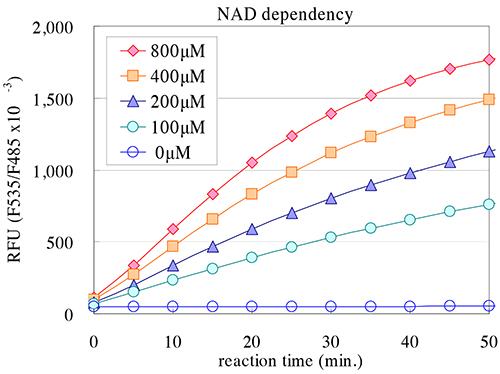CycLex SIRT6 Deacetylase Fluorometric Assay Kit Ver.2
| Code | Size | Price |
|---|
| MBL-CY-1156V2 | 100 Assays | £541.00 |
Quantity:
Prices exclude any Taxes / VAT
Overview
Regulatory Status: RUO
Shipping:
Dry Ice
Storage:
-70°C
Images
Documents
Further Information
Background:
Sir2 is a conserved protein and was recently shown to regulate lifespan extension both in budding
yeast and nematode. In 2000, it was reported that the yeast Sir2 protein is a NAD(+)-dependent histone
deacetylase that plays a critical role in transcriptional silencing, genome stability and longevity. In
mammals, the homologs of Sir2 have been named Sirtuins (SIRTs), with seven members in a family
termed SIRT1 through SIRT7. They share a conserved central deacetylase domain but have different Nand
C termini and display distinct subcellular localization, suggesting different biological functions (1).
The distant mammalian Sir2 homolog SIRT6 is a broadly expressed, predominantly nuclear protein (2)
like SIRT1. Inactivation of the Sirt6 gene in mice leads to dramatically shortened life span and a
premature aging-like phenotype (3). It was shown that SIRT6 is a histone H3 lysine 9 deacetylase, and
identified a role for SIRT6 activity at telomeric chromatin, where it prevents telomere dysfunction in
human cells (4). In addition, SIRT6 also deacetylates histone H3 acetylated lysine 56 in vivo to promote
genomic stability (5). In term of function, SIRT6 binds to the NF-κB subunit RELA and attenuates
NF-κB signaling by modifying chromatin at NF-κB target genes (6). Thus SIRT6-mediated control of
NF-κB prevents aging-associated, hyperactive NF-κB-dependent gene expression, and inhibition of
NF-κB can rescue the early lethality of Sirt6 knockout mice. Overexpression of wild-type Sirt6, but not
the catalytically inactive form, consistently resulted in increased tumor necrosis factor protein
production relative to its mRNA levels (7).
The conventional method for measuring SIRT6 activity is very complicated and laborious. In order to
measure SIRT6 enzyme activity, it is necessary to prepare radioactive acetylated histone H3 as a
substrate. First, cells have to be labeled metabolically with radioactivity by adding radioactive acetic
acid to the culture medium. Second, radioactive acetylated histone has to be purified from the cells.
Following the reaction, it is necessary to extract and separate the radioactive acetyl group, which has
been released from acetylated histone, using ethyl acetate to measure the activity of the enzyme based on
the radioactivity.
Although a method for measuring the activity of deacetylase without the use of radioactive substances
was reported in recent years, owing to the use of fluorescent-labeled acetylated lysine as a substrate, the
reaction product must be separated from the intact substrate and the fluorescent intensity measured by
reverse phase HPLC. As mentioned above, these measurement systems are difficult to adapt for
processing many samples under a variety of conditions, because of their complicated operation. Thus a
simple system for biochemical analysis as well as for inhibitor screening without the use of radioactive
substances is preferred.
Description:
This kit is designed for the rapid and sensitive evaluation of SIRT6 inhibitors or activators using recombinant SIRT6 or purified SIRT6.
Kit Components:
SIRT6 Assay Buffer, Fluoro-Substrate Peptide (0.1 mM), Fluoro-Deacetylated Peptide (0.1 mM), NAD (8 mM), Developer, Recombinant SIRT6, Stop Solution
Shelf Life:
1 year
Target:
SIRT6
References
1. North, B.J., and Verdin, E.; Sirtuins: SIRT6-related NAD-dependent protein deacetylases. Genome
Biol. 5: 224, 2004
2. Michishita E et al.; Evolutionarily conserved and nonconserved cellular localizations and functions of
human SIRT proteins. Mol Biol Cell. 16: 4623, 2005
3. Mostoslavsky R et al.; Genomic instability and aging-like phenotype in the absence of mammalian
SIRT6. Cell. 124: 315, 2006
4. Michishita E et al.; SIRT6 is a histone H3 lysine 9 deacetylase that modulates telomeric chromatin.
Nature. 452: 492, 2008
5. Yang B et al.; The sirtuin SIRT6 deacetylates H3 K56Ac in vivo to promote genomic stability. Cell
Cycle. 8: 2662, 2009
6. Kawahara TL et al.; SIRT6 links histone H3 lysine 9 deacetylation to NF-kappaB-dependent gene
expression and organismal life span. Cell. 136: 62, 2009
7. Van Gool F, et al.; Intracellular NAD levels regulate tumor necrosis factor protein synthesis in a
sirtuin-dependent manner. Nat Med. 15: 206, 2009



